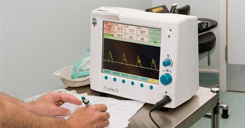


Doppler Ultrasound
A Doppler ultrasound test uses reflected sound waves to see how blood flows through a blood vessel. It helps doctors evaluate blood flow through major arteries and veins, such as those of the arms, legs, and neck. It can show blocked or reduced blood flow through narrowing in the major arteries of the neck that could cause a stroke. It also can reveal blood clots in leg veins (deep vein thrombosis, or DVT) that could break loose and block blood flow to the lungs (pulmonary embolism). During pregnancy, Doppler ultrasound may be used to look at blood flow in an unborn baby (fetus) to check the health of the fetus.
During Doppler ultrasound, a handheld instrument (transducer) is passed lightly over the skin above a blood vessel. The transducer sends and receives sound waves that are amplified through a microphone. The sound waves bounce off solid objects, including blood cells. The movement of blood cells causes a change in pitch of the reflected sound waves (called the Doppler effect). If there is no blood flow, the pitch does not change. Information from the reflected sound waves can be processed by a computer to provide graphs or pictures that represent the flow of blood through the blood vessels. These graphs or pictures can be saved for future review or evaluation.
The four basic types of Doppler ultrasound are:
- "Bedside" or continuous wave Doppler. This type uses the change in pitch of the sound waves to provide information about blood flow through a blood vessel. The doctor listens to the sounds produced by the transducer to evaluate the blood flow through an area that may be blocked or narrowed. This type of ultrasound can be done at the bedside in the hospital with a portable machine to provide a fast estimate of the extent of blood vessel damage or disease.
- Duplex Doppler. Duplex Doppler ultrasound uses standard ultrasound methods to produce a picture of a blood vessel and the surrounding organs. Also, a computer converts the Doppler sounds into a graph that gives information about the speed and direction of blood flow through the blood vessel being evaluated.
- Color Doppler. Color Doppler uses standard ultrasound methods to produce a picture of a blood vessel. Also, a computer converts the Doppler sounds into colors that are overlaid on the image of the blood vessel and that represent the speed and direction of blood flow through the vessel. Power Doppler is a special type of color Doppler. Power Doppler can get some images that are hard or impossible to get using standard color Doppler. Power Doppler is most commonly used to evaluate blood flow through vessels within solid organs
Doppler ultrasound is done to:
- Find blood clots and blocked or narrowed blood vessels in almost any part of the body, especially in the neck, arms, and legs.
- Evaluate leg pain that may be caused by intermittent claudication, a condition caused by atherosclerosis of the lower extremities.
- Evaluate blood flow after a stroke or other condition that might be caused by a problem with blood flow. Evaluation of a stroke can be done through a technique called transcranial Doppler (TCD) ultrasound.
- Evaluate abnormal veins causing varicose veins or other problems.
- Map veins that may be used for blood vessel grafts. It also can check the condition of grafts used to bypass blockage in an arm or leg.
- Find out the amount of blood flow to a transplanted kidney or liver.
- Monitor the flow of blood following blood vessel surgery.
- Find out the presence, amount, and location of arterial plaque. Plaque in the carotid arteries can reduce blood flow to the brain and may increase the risk of stroke.
- Guide treatment such as laser or radiofrequency ablation of abnormal veins.
- Check the health of a fetus. Blood flow in the umbilical cord, through the placenta, or in the heart and brain of the fetus may be checked. This test can show if the fetus is getting enough oxygen and nutrients. Doppler ultrasound may be used to guide decisions during pregnancy when:
- The fetus is smaller than normal for his or her gestational age (fetal growth restriction). Blood flow through the large blood vessel in the umbilical cord (the umbilical artery) can be looked at.
- Rh sensitization has occurred. Blood flow through a blood vessel in the brain (the middle cerebral artery, or MCA) can be used to monitor fetal health.
- The mother has other problems, such as preeclampsia or sickle cell disease.
A transcranial Doppler ultrasound (TCD) may be used in children with sickle cell disease to evaluate their risk of stroke. In adults, TCD can be used to evaluate blood flow in the brain.


